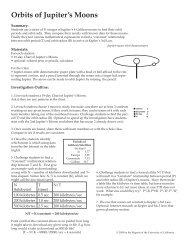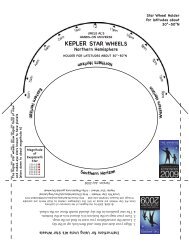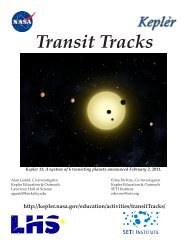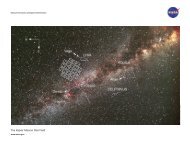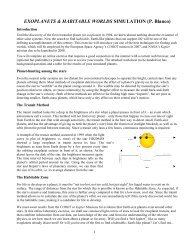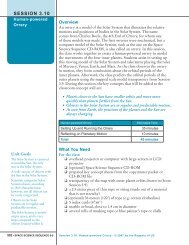Poster Abstracts - Kepler - NASA
Poster Abstracts - Kepler - NASA
Poster Abstracts - Kepler - NASA
- No tags were found...
You also want an ePaper? Increase the reach of your titles
YUMPU automatically turns print PDFs into web optimized ePapers that Google loves.
POSTER ABSTRACTSP0609. POSTER SESSION IIADVANCED ANALYSIS OF SURFACE FEATURES ON ACTIVE CLOSE BINARIES. G. J. Peters 1 andR. E. Wilson 2 , 1 Space Sciences Center & Department of Physics & Astronomy, University of Southern California,835 W. 37 St., Los Angeles, CA 90089-1341, gjpeters@mucen.usc.edu, 2 Department of Astronomy, University ofFlorida, wilson@astro.ufl.edu.Introduction: Close binaries show photometric andspectroscopic activity that includes mass transfer indirect impact Algol systems and magnetic spot variabilityin some cooler systems. Although the genericprocess of mass transfer in Algol binaries has beenunderstood now for about a half century, little is knownabout the detailed physics. For example, how is themass actually deposited on the mass gainer? What isthe extent of shock-induced heating in the photosphereand circumstellar material? Are there accretioninducedpulsations on the photosphere of the massgainer? Is the mass transfer rate uniform, or is the gasstream clumpy? What are typical fluctuations inamount and location of matter deposition due to sourceand stream fluctuations? How much mass and angularmomentum is lost from the system? The latter is importantfor computing the evolutionary tracks of Algols[1]. The physics of magnetic spot activity on the masslosers in Algol systems or in cool systems such as RSCVn binaries is a topic of current interest because ofimplications for convective envelope structure.The <strong>Kepler</strong> Program on Active Binaries: Among ourtargets are the Algol systems that have separationsclose enough that the gas stream impacts the photosphereof the mass gainer. The seven systems listed inTable 1 were identified as possible Algol binaries fromthe online Catalogue of Variable Stars in the <strong>Kepler</strong>Field of View [2]. Stars designated as EA with periodsgreater than 1.3 d were considered, as these are likelydirect-impact Algols. Each system has been monitoredat the long cadence for the duration of <strong>Kepler</strong> Cycle 2to investigate the basic variability in the light curves.Short cadence observations were obtained of each systemfor a duration of one month to look for microflaringand other short-term activity.Table 1 - Program StarsStar Period 1(days)Spectral Types 1 <strong>Kepler</strong>Mag.BR Cyg 1.3326 A3 V + G IV: 10.028WX Dra 1.8020 A8 V + K0 IV: 12.796UZ Lyr 1.8913 B9V + G-K1 IV: 10.672V995 Cyg 3.5565 B8: + G6 IV 11.882V461 Lyr 3.7217 A2 V: + K3 IV 12.746V810 Cyg 3.7363 A0 V: + G6 IV 13.931V850 Cyg 4.5645 A-B: + ? 11.2461 From catalogs of Budding [3] and Malkov et al. [4] andSimbad database.Light Curve Analysis: The light curves are beinganalyzed with an updated version the Wilson & Devinneycode [5],[6],[7],[8]. The most recent addition is athorough makeover of the program's spot capability,including major precision improvement for spotted starlight (and velocity) curves, spot motions due to driftand star rotation, and spot growth and decay [9].These enhancements apply to both accretion hot spotsand magnetic cool spots. The program's analysis capabilityincludes parameters for times of spot appearance,development, and disappearance. Important is that theinformation input is <strong>Kepler</strong> light curve data that exist inlong, essentially continuous, trains. A sample calculationfrom the new program is shown below (Fig.1).One type of variability that is often seen is unequal fluxlevels at the quadrature points that slowly disappears(or grows) during the course of a few orbital cycles.We have modeled this with a decaying hot spot thatinitially has a temperature of twice that of the localphotosphere. It should be mentioned that each of theprogram binaries has a unique light curve with its ownvariability pattern. UZ Lyr and BR Cyg are typicalshort-period Algol systems. V850 Cyg appears to consistof a cool pair with spectacular spot behavior. The<strong>Kepler</strong> light curves are revealing activity in shortperiodsystems that has never before been observed.We appreciate support from <strong>NASA</strong> NNX11AC78G.Fig. 1 - Calculated light curve for a 4.5 d binary with Teff=18000/14000 K and a decaying hot spot on the trailing hemisphere.References: [1] Van Rensbergen W. et al. (2008)A&A, 487, 1129-1138. [2] Pigulski A. et al. (2009),http://www.astrouw.edu.pl/asas/ ?page=kepler.[3] Budding E. et al. (2004) A&A, 417, 263-268.[4] Malkov O. Y., et al. (2006) A&A, 446, 785-789.[5] Wilson R. E. (1979) ApJ, 234, 1054-1066 .[6] Wilson R. E. (1990) ApJ, 356, 613-622. [7] WilsonR. E. (2008) ApJ, 672, 575-589. [8] Wilson R.E. & Devinney E. J. (1971) ApJ, 166, 605-619. [9]Wilson, R. E. (2012) in prep.2011 <strong>Kepler</strong> Science Conference - <strong>NASA</strong> Ames Research Center 181



